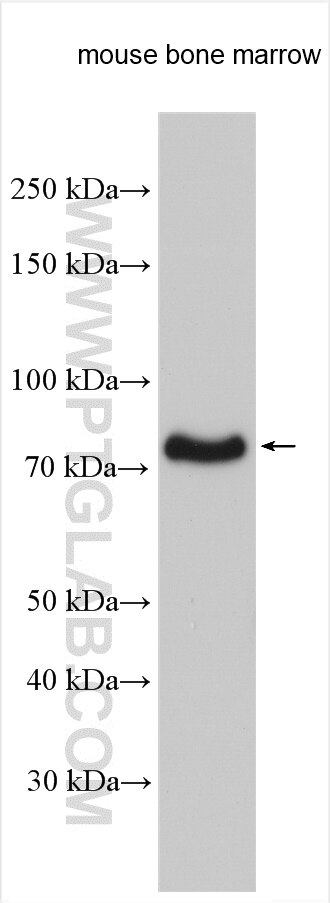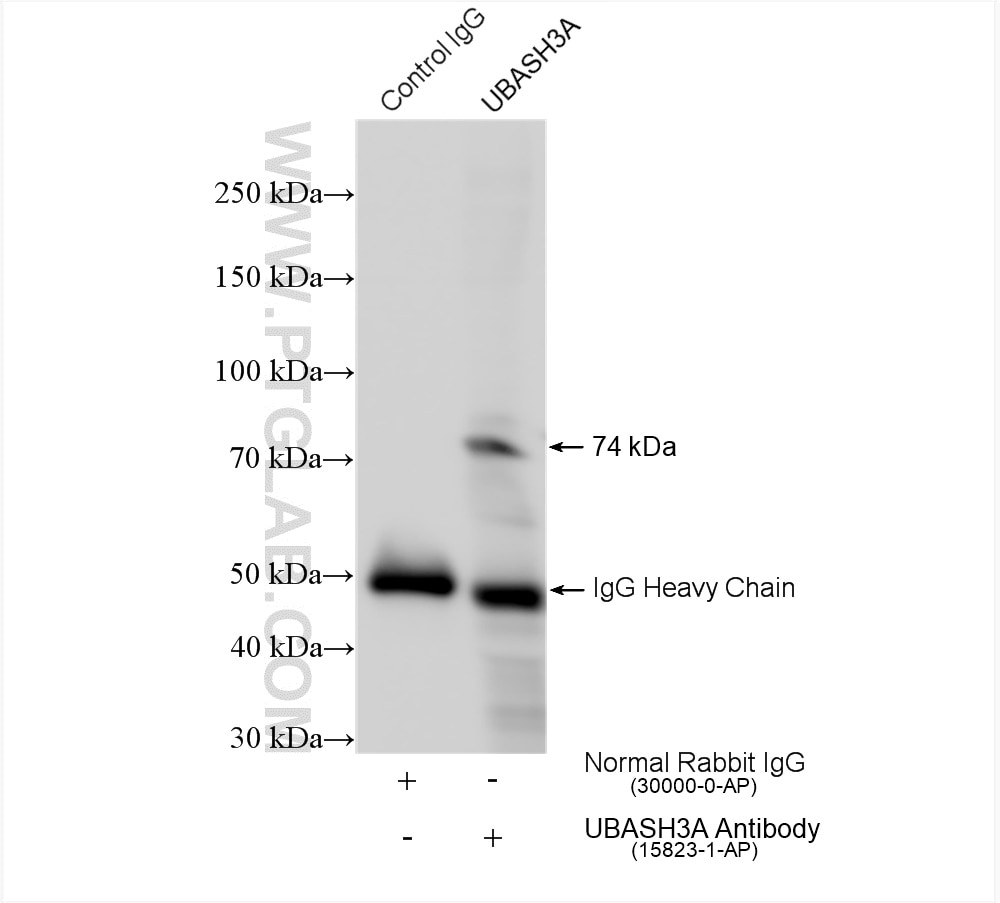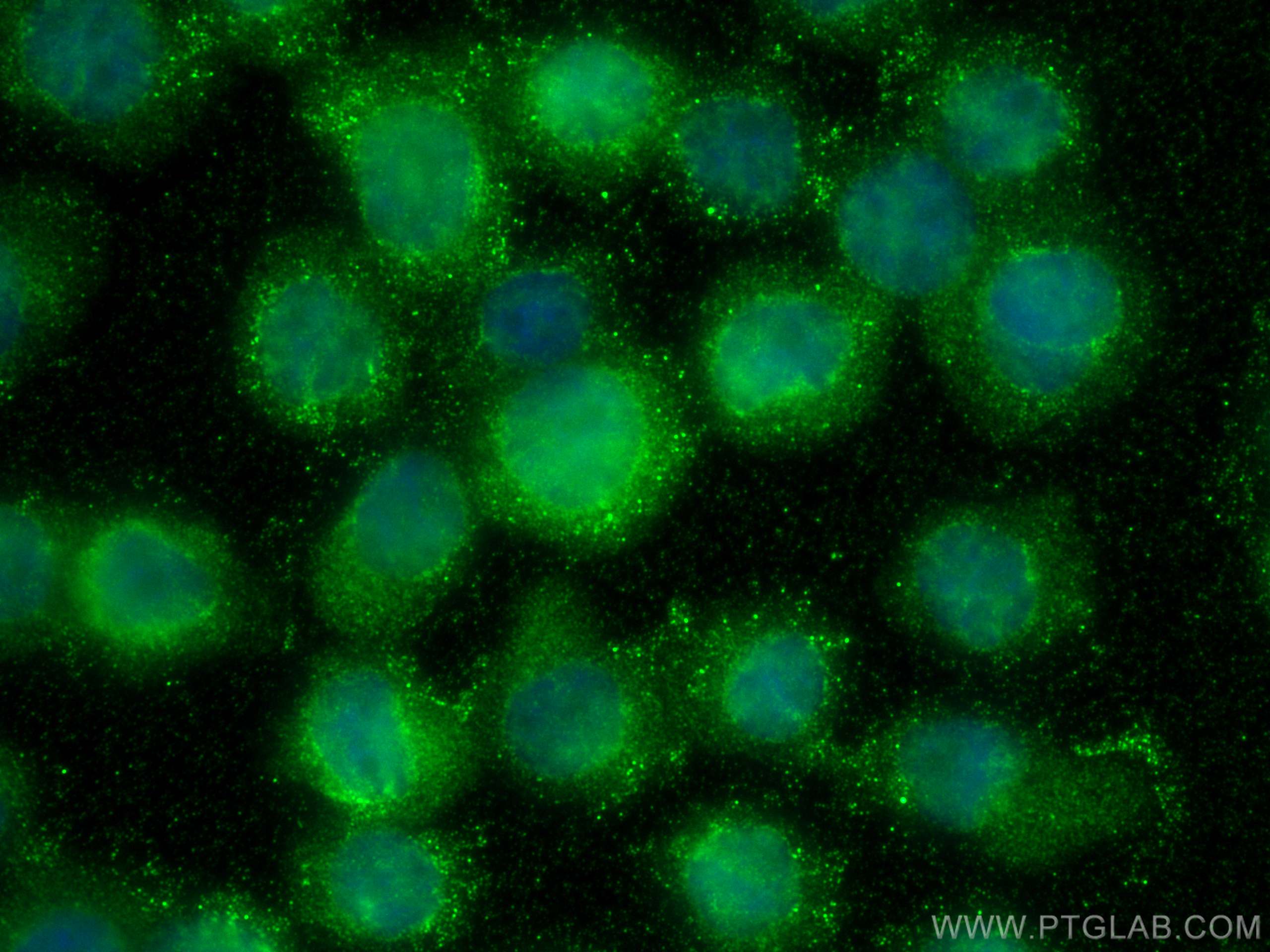UBASH3A-Specific Polyklonaler Antikörper
UBASH3A-Specific Polyklonal Antikörper für WB, IF/ICC, IP, ELISA
Wirt / Isotyp
Kaninchen / IgG
Getestete Reaktivität
human, Maus, Ratte
Anwendung
WB, IF/ICC, IP, ELISA
Konjugation
Unkonjugiert
Kat-Nr. : 15823-1-AP
Synonyme
Geprüfte Anwendungen
| Erfolgreiche Detektion in WB | mouse bone marrow |
| Erfolgreiche IP | Mausmilzgewebe |
| Erfolgreiche Detektion in IF/ICC | THP-1-Zellen |
Empfohlene Verdünnung
| Anwendung | Verdünnung |
|---|---|
| Western Blot (WB) | WB : 1:1000-1:8000 |
| Immunpräzipitation (IP) | IP : 0.5-4.0 ug for 1.0-3.0 mg of total protein lysate |
| Immunfluoreszenz (IF)/ICC | IF/ICC : 1:200-1:800 |
| It is recommended that this reagent should be titrated in each testing system to obtain optimal results. | |
| Sample-dependent, check data in validation data gallery | |
Veröffentlichte Anwendungen
| WB | See 7 publications below |
Produktinformation
15823-1-AP bindet in WB, IF/ICC, IP, ELISA UBASH3A-Specific und zeigt Reaktivität mit human, Maus, Ratten
| Getestete Reaktivität | human, Maus, Ratte |
| In Publikationen genannte Reaktivität | human, Maus |
| Wirt / Isotyp | Kaninchen / IgG |
| Klonalität | Polyklonal |
| Typ | Antikörper |
| Immunogen | Peptid |
| Vollständiger Name | ubiquitin associated and SH3 domain containing, A |
| Berechnetes Molekulargewicht | 74 kDa |
| Beobachtetes Molekulargewicht | 70-74 kDa |
| GenBank-Zugangsnummer | NM_018961 |
| Gene symbol | UBASH3A |
| Gene ID (NCBI) | 53347 |
| Konjugation | Unkonjugiert |
| Form | Liquid |
| Reinigungsmethode | Antigen-Affinitätsreinigung |
| Lagerungspuffer | PBS with 0.02% sodium azide and 50% glycerol |
| Lagerungsbedingungen | Bei -20°C lagern. Nach dem Versand ein Jahr lang stabil Aliquotieren ist bei -20oC Lagerung nicht notwendig. 20ul Größen enthalten 0,1% BSA. |
Hintergrundinformationen
UBASH3A gene encodes ubiquitin-associated and SH3 domain-containing protein A (UBASH3A) also known as T-cell ubiquitin ligand 1 (TULA1) which is one of two family members belonging to the T-cell ubiquitin ligand (TULA) family. UBASH3A gene expression is limited to only a few tissues, with its highest expression in spleen, peripheral blood leukocytes, and bone marrow. UBASH3A protein is associated with c-Cbl and ubiquitylated proteins and has been implicated in the regulation of signaling mediated by protein-tyrosine kinases oth family members can negatively regulate T-cell signaling. UBASH3A can facilitate growth factor withdrawal-induced apoptosis in T cells via its interaction with apoptosis-inducing factor (AIF). This antibody is UBASH3A-specific.
Protokolle
| PRODUKTSPEZIFISCHE PROTOKOLLE | |
|---|---|
| WB protocol for UBASH3A-Specific antibody 15823-1-AP | Protokoll herunterladen |
| IF protocol for UBASH3A-Specific antibody 15823-1-AP | Protokoll herunterladen |
| IP protocol for UBASH3A-Specific antibody 15823-1-AP | Protokoll herunterladen |
| STANDARD-PROTOKOLLE | |
|---|---|
| Klicken Sie hier, um unsere Standardprotokolle anzuzeigen |
Publikationen
| Species | Application | Title |
|---|---|---|
Diabetes UBASH3A Mediates Risk for Type 1 Diabetes Through Inhibition of T-Cell Receptor-Induced NF-κB Signaling. | ||
Int J Mol Sci UBASH3A Interacts with PTPN22 to Regulate IL2 Expression and Risk for Type 1 Diabetes | ||
BMC Cancer FLI1 induces erythroleukemia through opposing effects on UBASH3A and UBASH3B expression | ||
Immunity TCR signaling promotes formation of an STS1-Cbl-b complex with pH-sensitive phosphatase activity that suppresses T cell function in acidic environments | ||




